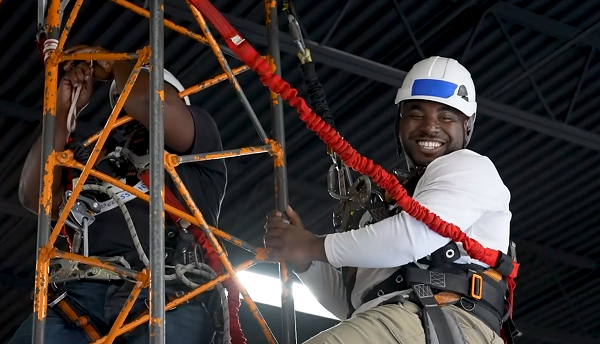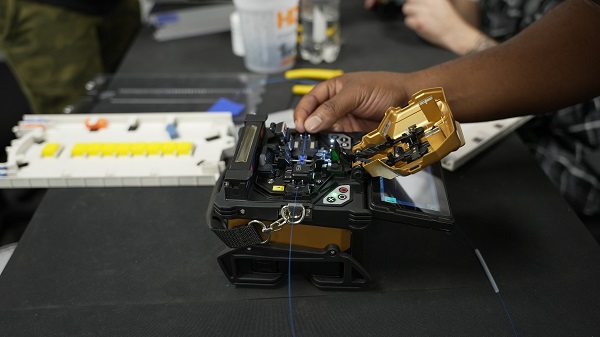Job Opportunities in Telecom
Tower Technician
Build, maintain and outfit macro-cell tower site with all required antennas and coaxial/fiber optic cables that produce wireless signal in a broad area of coverage.

Fiber Technician
Construct outside fiber plant related infrastructure through the use of industry related tools like OTDRs, microscopes, and fusion splicers that provide the ability to connect fiber into vaults and enclosures.

Wireless Technician
Install and provide maintenance to varying wireless technologies such as distributed antenna systems, in-building wireless, WiFi and micro-cell/small cell options that distribute 5G speeds.

Job Growth, Requirements and Technical Standards
Telecommunications Foreman and Managers
| Employment | Median hourly wage | Median annual wage |
|---|---|---|
| 8% Job Growth | $47.55 | $98,890 |
Telecommunications Project Manager
| Employment | Median hourly wage | Median annual wage |
|---|---|---|
| 7% Job Growth | $45.43 | $94,500 |
Telecommunications Safety Manager
| Employment | Median hourly wage | Median annual wage |
|---|---|---|
| 5% Job Growth | $36.00 | $74,870 |
Tower Climbing Fundamentals
- Authorized Climber (Competent Climber – Safety LMS)
- Authorized Rescue (Competent Rescue – Safety LMS)
- Basic Rigging/Capstan/Hoist
- Material Handling, Loading and DOT Standards
- Installation on Multiple Structures
- Small Cell/5g
Hazard Assessment and Safety
- OSHA 10
- Personnel Protective Equipment
- CPR/First Aid/Blood Borne Pathogen
- RF/EME Hazards and Meter
- Jobsite Hazard Analysis
- Statement of Work
- Introduction to Standards
Telecommunications Fundamentals
- Basic Rigging/Capstan/Hoist
- Material Handling and Operation of Vehicles (DOT Standards)
- Installation on Multiple Structures
- Small Cell/5G Equipment
- Computer Literacy and Soft Skills
Fiber Optics
- Overview of fiber optic applications & installations communications systems utilizing fiber optics
- FTTx Workshop
- Antenna Types
- Field experience installing and testing fiber optic networks
Industry knowledge
- Telecommunications Fundamentals
- Digital Communications & Internet Protocol
- Introduction to Wireless Communications
- Introduction to Microwave & Radio Transmission Systems
- DAS Fundamentals
Structured wiring
- Structured wiring
- Cable theory
- Commercial and Residential Installation
- Ladder safety and handling
- Bucket truck operation and safety
Installation on multiple structures
- Identification of Structures & their Unique Challenges
- Mitigating Risks Posed by Structures
- Rigging Challenges for Each Structure
- Proper Installation of Antenna/Small Cell on Various Structures
- Rooftop Deployment & Small Cell
Technical Skills
- Equipment/System Installation
- Testing, Troubleshooting & Maintenance/Repair
- Job Site Management & Security
- Job Site Process & Operations
Operate Hand & Power Tools
- Types of Hand & Power Tools
- Identification of Accessories
- Proper Handling Techniques of tools
- Safe usage of power tools
To participate in any hands-on training program at Learning Alliance Corporation, each student, with or without reasonable accommodations, must safely and effectively meet the following technical standards in addition to academic standards. We provide virtual walk throughs for prospective students to view prior to enrollment so that you may assess the technical standards in reference with our facility layout.
- Facility Walk Through:
- Use of Senses: Prospective and current students must:
- Possess sufficient visual acuity to identify, read, and understand directions and gauges on equipment and other documents required in the installation of all aspects of wireless cell site foundations.
- Be able to hear sounds and warning signals in a training facility or cell tower location with high ambient noise levels, which could lead to an emergency situation requiring some type of proactive or reactive response.
- Be able to feel vibrations or unusual shaking indicating that a possible danger exists in the installation or maintenance of all aspects of wireless cell site foundations.
- Be able to detect smells that may indicate a possible danger involved in the installation or maintenance of all aspects of wireless cell site foundations.
- Motor: Prospective and current students must be able to execute physical movements needed to install and maintain wireless cell site foundations, including but not limited to:
- Being able to install equipment.
- Being able to operate aerial lifts, man lifts, skid steers and aerial platform equipment.
- Being able to climb and perform work at various heights, up to 400 feet, for long periods of time.
- Being in good physical condition with the ability to stoop, crawl, bend at the knees and waist, squat and lift fifty pounds; includes body weight, equipment, tools and boxes.
- Being able to pull his/her own body weight plus equipment weight up a vertical tower repeatedly for long periods of time.
- Intellectual and Cognitive: Prospective and current students must:
- Comprehend the need for a safe working and training environment.
- Exhibit a practical awareness of potential dangers of installing wireless cell site foundations.
- Be able to maintain a safe environment at all times.
- Be able to work in a fast-paced environment without jeopardizing safety.
- Be able to react and adjust as coached by the instructor(s) during instruction.
- Be able to troubleshoot and correct mechanical or electrical connections.
- Be able to motivate, lead, teach and train on proper work and safety procedures.
- Communication: Prospective and current students must:
- Communicate effectively, both orally and in writing, in academic and instructional settings to gather and convey information.
- Be able to read, comprehend, and carry out instructions.
- Behavioral and Social Attributes: Prospective and current students must:
- Maintain composure and professionalism at all times, including in the classroom and while training.
- Effectively handle stress and continue to function safely in a variety of situations and interactions.
In addition to the above standards, prospective and current students must meet all state and federal regulation standards governing installation of all aspects of wireless cell site foundations.
Inclusion statement
Learning Alliance Corporation (“LAC”) does not discriminate against qualified individuals with disabilities who apply for admission to, or who are enrolled in any of its programs. Otherwise qualified individuals shall not be excluded from admission or participation in its programs and activities solely by reason of their disability or medical condition. LAC is committed to providing reasonable accommodations to qualified students with properly documented disabilities who meet the minimum program requirements. A reasonable accommodation is one that does not require a fundamental alteration in the nature of the program or lower academic standards.
Should a current or prospective student have or develop a disability that poses a risk to the health and safety of the student or others that cannot be eliminated with a reasonable accommodation, the person may be denied admission to, or removed from the program.
Enroll in a
Program Today
Program Description: The program focuses on the understanding and applying of new techniques in electronic technology for the aim of testing, maintaining, repairing, and upgrading digital as well as analog communication systems. The program also covers fundamentals of digital communications, its applications and how information technology converges create robust synchronous telecommunications systems. The program is designed to be an integrated educational curriculum taught using an applied, and theoretical approach. With the expansion of 5G wireless and 10G broadband, it is important to learn the fundamentals of digital communications, its applications and how information technology converges to create robust synchronous telecommunications systems. This program is specifically designed to guide the student in learning modern day communication system design and its correlating infrastructure. The topics also include wired, wireless, and point to point technologies that create mesh networks which enable instantaneous communication between two or more individuals.







